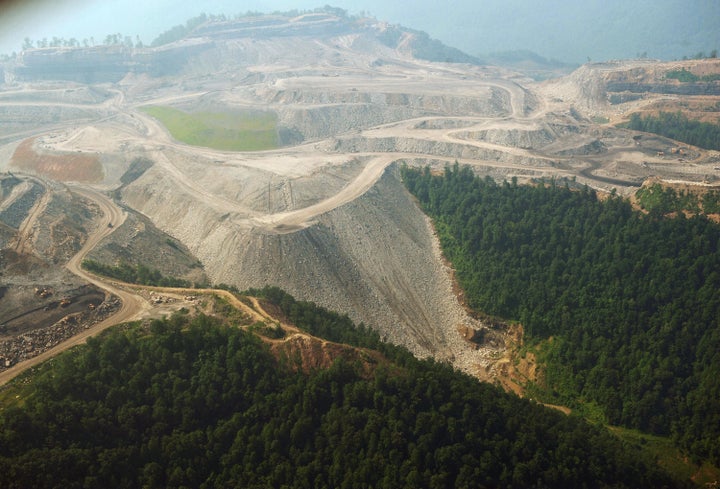
As the historic tree-sit on Coal River Mountain finishes its third week, and the Mountaintop Removal Moratorium Now movement grows, a broad alliance of local residents and activists in the Coal River Valley of West Virginia are drawing national attention to an upcoming public hearing to consider the renewal of a violation-ridden permit for a controversial strip mine.
This is ground zero in the anti-mountaintop removal movement, the last mountain along the historic Coal River Mountain range, where the very legacy and communities of beloved Appalachian leader and Coal River resident Judy Bonds remain under threat.
"Coal River Mountain is under attack now from the coal company called Alpha and their 'running right' campaign," said Debbie Jarrell, with the Coal River Mountain Watch citizens group. "There is nothing right about destroying a people and the environment that they live in."
The next round in the Coal River Mountain showdown over planned mountaintop removal operations takes places on Tuesday, August 9th, at a state-sponsored public hearing at the Raleigh Boone Technical Center in Pettus, West Virginia.
Jarrell, who was featured in the award-winning documentary, On Coal River, recently noted:
As I drive to work this morning, down Route 3, headed to Whitesville, thoughts of a dying community member fill my head. Thirty years old and death has come to her doorstep by way of cancer. Thoughts of my own father, as I know he is heading to the cancer center for another round of chemo treatments. I look around me as I pass places where people used to live, places where houses used to be, businesses used to thrive, and places where mountains that used to be, provided life-giving things such as water and food.
Citing the mine's violation-ridden track record, Coal River Mountain Watch, among other groups, are calling on the DEP to reject Alpha's application to renew the Bee Tree strip mining permit.
Last week, Coal River Mountain Watch representative Rob Goodwin and other local residents joined West Virginia Department of Environmental Protection Supervisor Tom Wood and two engineers from Marfork Coal Company, the Alpha Natural Resources subsidiary company, for a citizens' inspection of the 1,095 acre Bee Tree strip mining permit on Coal River Mountain.
In an analysis of the water quality data from the Bee Tree Branch, Goodwin's inspection with state officials found "quickly escalating levels of aluminum in a stream into which the Bee Tree mine discharges."
Goodwin's deliberate report notes how Alpha/Markfork's strip mining operations are able to circumvent regulatory requirements for valley fills:
We traveled up onto the active portion of the strip mine to assess what land Marfork had mined recently, what land Marfork was mining presently, and to gauge how quickly and where Marfork is going to progress with its next destruction. Marfork's permit plans to use 200 of its 1,095 acres for non-mining purposes such as construction and roads. From this portion of the land, the company can only collect 'incidental coal,' or coal that is acquired as a result of constructing roads. Marfork currently plans to mine 200 acres, and has begun strip mining on a little more than 75 acres of this portion of the permit. The EPA has stalled valley fill permits for the Bee Tree site, but Marfork is getting around this obstacle by strip mining without filling valleys. It is likely that Marfork will submit plans to mine a significantly larger portion of the 800 proposed acres. Mark King repeatedly said that how far the company goes all depends on the market for coal. He guaranteed us that he would get another five productive years out of this permit as it stands.
Goodwin's inspection notes a number of unanswered questions about the impact of the mine's blasting near the class "C" Brushy Fork impoundment, one of the largest and potentially weakest coal slurry impoundments in the nation. According to past evacuation reports, a break in the coal slurry impoundment would result in certain injury or death for the nearly 1,000 residents downslope in the valley. Some area residents would have less than 15 minutes to escape a 72-foot tidal wave of coal slurry.
According to Goodwin, local residents have planned to "file a request to return to the site and inspect the seismographs, piezometers, blasting logs, and seven-day impoundment inspection reports to verify Marfork's data on the effect of Bee Tree blasting on the Brushy Fork impoundment."
Goodwin also cites a number of concerns over health, environmental and other safety issues:
Marfork has already been issued several violations by the DEP. We moved on to inspect the area where two violations were issued in March of 2011. One violation was for material that had ventured down the slope off the permit area. The company also received a violation for failing to establish proper sediment control at the top of the slope, likely resulting in the landslide. The abatement requirements were very standard of the WV DEP enforcement; the company received a small fine of $3,000 and the DEP told them to remove the material from the non-permitted area and place it in a stable location. They were also required to revise their permit to include that area that had been disturbed. Although they have mostly cleaned up the material, they have not done so to a satisfactory degree, and they have yet to submit the revision to include the additional area of the permit.
We examined a third violation at the part of the mine apportioned for non-mining purposes. The company has created a deep cut in the mountain for a road called IBR 2. Cutting this road provided an excuse to extract the "incidental coal." About a year ago, they were issued a violation for augering into the sides of the mountain in this area with the highwall miner, a form of mining growing in popularity with increased scrutiny of valley fill permits by the EPA.
Despite a specific and clear provision in the permit disallowing highwall mining in this area, the company went ahead and used the machine. Coal River Mountain Watch had warned the DEP of this potential problem just weeks before it happened and the DEP failed to prevent the company from willfully violating the law. Although the wall is now covered up, we were told that there were about 6 holes drilled into the side of the mountain. The company received a $774 fine for this violation. Marfork made a lot more money off the coal recovered than that violation cost them, and they likely would have made a lot more if CRMW had not raised concerns because who knows how far they would have gone unchecked.
"I'm following coal trucks, with their heavy loads, all in a line headed to the coal docks in Charleston, and white pick-up trucks with Virginia license plates," Jarrell wrote recently. "I pass a dead momma bear and her cub as they lie motionless beside the road. Death, it seems, is all around us now. I have tears in my eyes as I think of what used to be the Coal River Valley, how I yearn to turn back the clock to a time that was simpler, and a child could run and drink from the creeks as needed. Things are beginning to look foreign to those of us that lived here before. A time before mountain top removal, strip mining, and toxic sludge impoundments, such as the one that now sits in Marfork, a part of Coal River Mountain, a place that my ancestors once called home."
As the anti-mountaintop removal movement continues on several different fronts, residents are simply asking: What would Judy Bonds do?
